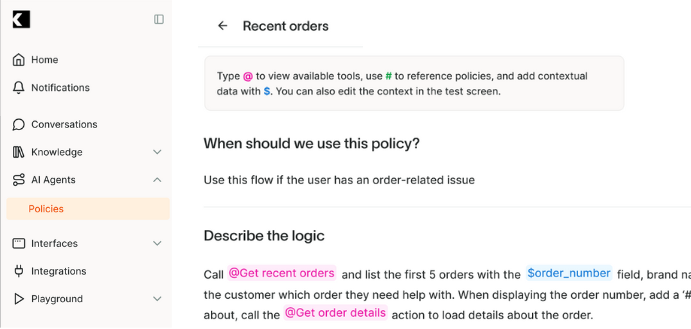Ingredients
Recharge, Salesforce Service Cloud, and Kodif.
What are AI Policies?

At Kodif, we’re excited to announce the launch of Policies—a powerful, dynamic solution designed to revolutionize the way CX managers handle customer support. Unlike traditional flows, which are rigid and complex, Policies empower non-technical users to create and manage customer interactions with ease. Written in natural language, Policies make it simple to define and refine customer experiences without needing to rely on complicated flowcharts or scripting. This approach is not only user-friendly but also self-serve, enabling CX teams to quickly translate existing Standard Operating Procedures (SOPs) into automation, saving valuable time and resources.
The flexibility of Kodif Policies ensures that businesses can offer personalized, context-driven support while continuously improving customer experiences. With Policies, you can experiment with different strategies to optimize outcomes such as CSAT, revenue, and retention—all without the need to rebuild complex workflows. Whether it’s automating routine interactions or testing new approaches for high-stakes scenarios, Policies provide a scalable, adaptable solution that aligns with your business goals. While flows still have their place in sensitive, high-risk situations, Policies offer an agile alternative that helps businesses innovate faster and deliver exceptional, tailored experiences at scale.
“Update email address” ticket type explained
In the realm of customer support, the “Update email address” ticket type refers to requests from customers who wish to change the email associated with their account. This is a common occurrence as customers may change their primary email due to various reasons such as personal preference, security concerns, or shifting to a new email provider. Efficient handling of these requests is crucial as it directly impacts the customer’s ability to receive important communications, manage their subscriptions, and access their account. By automating this process, businesses can ensure accurate and swift updates, thereby enhancing customer satisfaction and reducing the workload on support teams.
Which Platforms does this AI policy work on?
This AI policy is compatible with Recharge, Salesforce Service Cloud, and Kodif. Moreover, Kodif integrates seamlessly with all other major platforms, providing a versatile solution for businesses operating in diverse environments.
When should I use this policy?
Use this policy when a customer requests to update the email address associated with their account. The automation ensures that the process is handled efficiently and accurately, minimizing errors and freeing up customer support resources for more complex issues.
Policy logic
The logic for updating an email address involves a systematic approach to verify and process the request:
- Ask for the user’s current email address:
-
Use
@get_recharge_account_detailsto check if the provided email exists in Recharge. -
Ask for the New Email Address:
-
Request the customer to provide the new email address they wish to use.
-
Check for Duplicate Accounts:
- Use
@check_email_existsto ensure the new email address is not already linked to another account. -
If it is, use the macro: “The email address you provided is already linked to another account. Please provide a different email address or contact support for further assistance.”
-
Update the Email Address in Recharge:
- Use
@update_customer_email(current_email: str, new_email: str)to update the customer’s email in Recharge. - Inform the customer that their email has been successfully updated.
Example policy
Here is an example policy to illustrate the process:
- Ask for the user’s current email address:
-
Use
@get_recharge_account_detailsto check if the provided email exists in Recharge. -
Ask for the New Email Address:
-
Ask the customer to provide the new email address they want to use.
-
Check for Duplicate Accounts:
- Use
@check_email_existsto verify if the new email address is already associated with another account. -
If it is, use the macro: “The email address you provided is already linked to another account. Please provide a different email address or contact support for further assistance.”
-
Update the Email Address in Recharge:
- Use
@update_customer_email(current_email: str, new_email: str)to update the customer’s email in Recharge. - Confirm with the customer that their email has been successfully updated.


